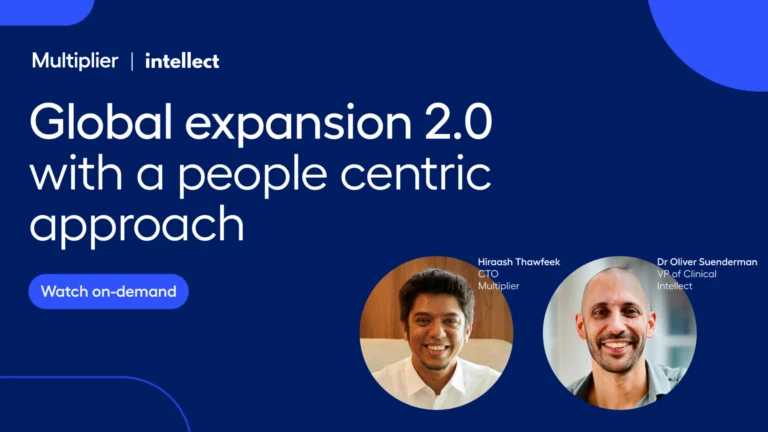The pandemic. The rise of remote and hybrid work. Ongoing financial uncertainty. The dawn of AI. An $8.5trn talent crunch. The global employment landscape has changed radically in the last few years—and the transformation is only getting faster.
To help HR leaders navigate this constantly changing landscape, we at global employment platform Multiplier have compiled a bumper State of Work report stuffed to the brim with research, predictions, and trend spotting for the coming year.
Finding it a lot to take in? We’ve got you. In today’s edition of the Debrief, Sagar Khatri, our Co-Founder and CEO, walks through the report’s key findings and offers his perspective on the many trends we’ve uncovered.
Replacing silos with agile and effective solutions
In previous discussions with Sagar, we’ve discussed the necessity for every company to adopt a global mindset from day one—chiefly due to the talent crunch. Access to talent is essential, and since it can’t always be found locally, companies need to source workers from across the globe.
With globally distributed workforces becoming the norm, our report makes clear the importance of ensuring geographically isolated teams don’t work in silos—and Sagar concurs.
“As companies go global, the complexities of HR operations are also increasing,” he says. “Consider a company with just one location. They need only one office, one insurance provider for that country, one payroll system, one HR system, and so on.
“When companies operate globally, however, that complexity is multiplied by the number of countries in which they are present. This makes it immensely complicated and almost impossible to manage in-house,” Sagar explains.
Thankfully, there’s a solution at hand: integration.
“For companies to expand globally, they need an integrated global system to ensure there are no silos. Having one source of truth is crucial to ensure compliance in every market.”
Skills will shape the working world, not degrees
Another intriguing consequence of the increasingly global nature of employment is the importance of skills over degrees.
“Increasingly, we’re noticing that what you study often has no relevance to what you end up doing,” says Sagar. “For instance, at a rough guess, about 50% of people at Multiplier have chosen different fields of study to the one they now work in. I myself studied civil engineering, started my career as an investment banker, and am now the CEO of a software company.”
Degrees are no longer the signifier they once were because comparing differing courses and standards worldwide is hard.
“Yes, if you’ve graduated from a top-tier university, it indicates that you likely have a certain aptitude for quickly acquiring new skills. However, the real question is: do you have prior experience in digital marketing, design, or sales?”
Continuing the shift toward work-life integration
As the boundaries between work and home life continue to blur, the report also covers how we are transitioning from the phenomenon of work-life balance to that of work-life integration.
“Last week, as well as this week, I’m working from my hometown in India, despite typically residing in Singapore,” Sagar explains. “The reason for my stay in India is our most celebrated festival, Diwali. Thankfully, I can spend time with my loved ones in my birth country, where my family resides, and still maintain my work commitments. I can connect with my work, attend client meetings, and participate in internal meetings without choosing between the two.
“We are progressing towards a phenomenon where work seamlessly integrates with your life. That means, for instance, I might choose to start my workday at 6 AM and then opt to visit the gym at 2 PM. Or if you’re a working parent, you can wake up, get your kids ready for school, send them off, and then start working. It’s about being able to truly design your own working hours.”
Sagar’s appreciation of this flexible boundary between work and home life is amplified by prior experience. “I began my career in a Japanese company where, if you were supposed to be there at 8:00 AM but arrived two minutes past, you were considered late. Let’s be honest, a one-size-fits-all culture like that is not effective today. People crave flexibility and prefer to set their own schedule.”
Smarter hiring and team management with AI
Perhaps the biggest question on everyone’s lips regarding the state of work in 2024 is how much AI will disrupt it. Over the past year, there have been numerous developments in automation, particularly with large language models and image generation. What do such advances mean for jobs?
Sagar makes a comparison to another revolutionary technology: the internet. “When the internet emerged in the late 1990s, early 2000s, there were similar questions being asked as there are today about AI—whether it would replace humans and so on. However, as it turned out, it created more jobs.
“The entire concept of working, being distributed and connected online would not have been possible without the internet. I believe every innovation that emerges ultimately aids in productivity.”
Solving the productivity puzzle
Multiplier itself is proof positive that AI can indeed be a productivity-boosting rather than job-destroying technology.
“I am a big fan of AI assisting humans and making the workforce more productive,” says Sagar. “Every engineer at Multiplier currently uses AI-based solutions, which help them code better and faster, increasing their productivity by 20 to 30%.”
It’s not just coding. Part of Multiplier’s aim is to extend the benefits of automation to the HR industry.
“Regarding HR, our challenge and mission from day one has been automating the HRIS function. Much of it involves compliance, payroll, and payments—all areas where AI can assist, but not completely replace roles.”
The rise of internal mobility: move around, not out
Another consequence of increasingly distributed teams is the importance of maximizing the human resources at your disposal. After all, as companies grow and scale, existing employees possess the most context about how the business works.
“This year, we have promoted more managers internally than we have hired externally,” Sagar confirms. “There are several reasons. In the past, when there was only one office per business, you could tap someone on the back to ask them quick questions.
“Today’s teams are globally distributed, however. While this has many advantages, one disadvantage is the absence of such immediate communication. That’s why existing employees, who have undergone strong onboarding processes, have been with the company for a long time, and have established relationships in the business, find it easier to be promoted and assume new responsibilities.”
Another motivating factor is cost. “Given the times we are in, cost and profitability are once again important parameters—and cash flow is becoming increasingly significant,” says Sagar. “Promoting homegrown leaders from within the company is always more cost-effective.
“I’m not referring to salary, but rather to the time and resources invested in training. The reality is that if someone in the company can take up a role, it’s always an easier, better, and more cost-effective option.”
Employee health & well-being is still a top priority
While we’re on the subject of making the most of every employee, the report also uncovered a movement towards ensuring employees can do their best work by supporting their health and well-being. That’s being driven by economic factors changing the way companies are structured.
“We are in an era where interest rates are at 5%, a 20-year high,” says Sagar. “Therefore, it becomes extremely crucial for organizations to be lean and nimble.
“Once you operate an organization that isn’t bloated, it’s vital to support every pillar of your business—because everyone carries heavier loads than before.”
Losing these vital employees can be disastrous, making employee retention incredibly important. “What matters is their engagement, motivation levels, and, in truth, their financial reward. It’s crucial that you invest in the people you want to keep and ensure that they stay with you and help build your organization.
The evolution of the gig economy
So far, we’ve been focusing on the relationship between companies and their salaried employees, but 2024 will require companies to also deeply consider their relationship with freelancers.
“Increasingly, people are choosing to monetize their skill sets and share them with more than one company,” says Sagar. “As a company, you may not need 100% of their time; you just need their skills.
“As a result, we will see a rise in contract and contingent workforces and skill-based employment, where you hire individuals for a specific period. You bring them in, pay them a premium, and they do the work. At the same time, they might be doing the same thing for 10, 15, or 25 different companies.”
This new type of worker is a decisive break from the past when the jack-of-all-trades was a more common template.
“Back in the day, when I was starting to work, people were very attracted to being generalists,” says Sagar. “We are moving away from that, towards a phenomenon where people want to become experts in certain areas and monetize that expertise.
“They realize that companies only need them to set up SOPs, establish processes, install systems and solutions, hire talent, build up a team, and then they can replicate this in multiple organizations. That’s where they can make the most money, deliver on their expertise, and derive the most satisfaction.”
Recognition to reinforce diversity, equity, and inclusion
Happily, we’re expecting companies in 2024 to reinforce their commitment to diversity, and one of the simplest ways to achieve this is by enabling global employment.
“I grew up in a remote part of India, and my mother stopped working after I was born,” says Sagar. “Despite being more educated than me by any measure, she chose to take care of her children. This is not unique to India; in most parts of Asia, women often take a backseat after marriage or childbirth.”
The fact is that global employment and work-from-anywhere policies inherently promote more inclusivity by broadening access to the workplace. But there are reasons beyond selflessness to make your company more inclusive.
“Take Multiplier, for example; today, we have a customer base across 60-70 countries,” Sagar explains. “How do you create a product used by such a diverse group of people, such diverse buyers across the globe? By incorporating that diversity into your company’s DNA.”
The big “return to the office”
Much has been made in some quarters about the need to bring workers, who have increasingly adopted remote or hybrid working practices in the wake of the pandemic, back into the office. But to worry about where employees work from may be missing the point.
“Organizations went global long before the phenomena of ‘remote work’ or COVID-19 came into the picture,” says Sagar. “The fundamental driver of going global is not enabling your employees to work remotely, but a response to the talent crunch,” Sagar explains.
This talent crunch isn’t going anywhere soon because of its widespread and deeply ingrained causes.
“For instance, China’s one-child policy created a talent crunch because their economy boomed, but they didn’t have enough people,” says Sagar. “Or consider Japan. Its population is declining, the marriage rate is decreasing, and the number of children per couple is reducing.”
Global employment is too often confused with remote work, but the truth is that global employment doesn’t rely on employees working from any specific location. “No one is saying that you should hire globally and then exclusively ask them to work from home, although that is an option,” says Sagar. “We have offices in India and Singapore and people who work there in a hybrid manner. Sometimes, they are in the office; sometimes, they work from home.
“The reality is, it’s about preferences. Some people prefer to work in our office, some prefer to work in a cafe, while others prefer to work out of their homes. If you want to be an employer of choice, give employees the option to work from anywhere.”
Read Multiplier’s 2024 State of Work Report
Now you’ve got the big picture, we’d recommend diving into the nitty gritty of the report itself to equip yourself for the year ahead.
After all, 2024 is shaping up to be anything but boring. Expect innovation in everything from hybrid work to learning and development, internal mobility, and more. To succeed in 2024, HR and business leaders must up their game by driving fresh initiatives and embracing global employment.
Multiplier is here to help businesses scale their global workforces and access the skilled workers they desperately need. Ready to boost your productivity with global talent but need help figuring out where to begin? Talk to our experts.








